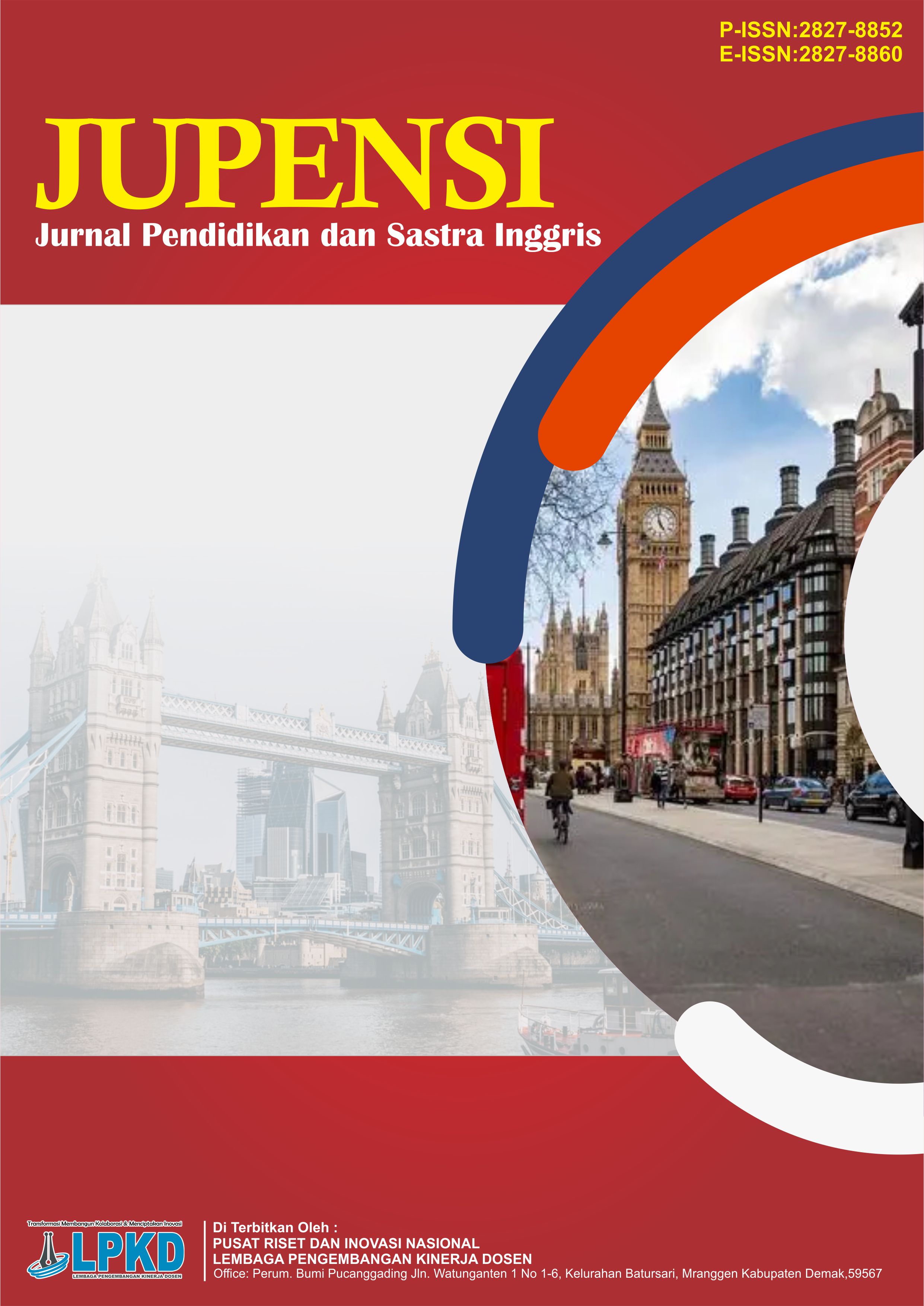Types and Meanings of Idiomatic Expressions in Justin Bieber’s Songs
DOI:
https://doi.org/10.55606/jupensi.v5i3.6228Keywords:
Idiom, Idiomatic Expression, Justice Album, Meaning, SongAbstract
This research delves into the linguistic intricacies of Justin Bieber's Justice album, employing a comprehensive documentation analysis approach. The study aims to identify and categorize idiomatic expressions within the album, utilizing Fernando's (1996) typology, and subsequently, to explore the associated meanings through Leech's (1981) semantic framework. The research spans a ten-month period from March to December 2023, with a primary focus on idioms in the song lyrics. Through meticulous examination of a diverse range of idiomatic expressions, including pure idioms, semi-idioms, and literal idioms, the study unveils the prevalence and diversity of figurative language in Bieber's songwriting. Furthermore, an in-depth analysis of idioms' meanings reveals a predominance of connotative meanings, underscoring the album's richness in emotional and contextual nuances. The research not only advances our understanding of idiomatic expressions but also contributes to broader linguistic and pedagogical contexts. The findings offer valuable insights for English language learners, educators, and researchers, emphasizing the incorporation of contemporary music in language acquisition and the nuanced exploration of meaning types within idioms.
Downloads
References
Alhaysony, M. H. (2017). Strategies and difficulties of understanding English idioms: A case study of Saudi university EFL students. International Journal of English Linguistics, 7(3), 70–84. https://doi.org/10.5539/ijel.v7n3p70
Ariyani, E. (2021). Types and meanings of idiomatic expressions used in Bruno Mars' songs. Linguistics and ELT Journal, 9(1), 37–43.
Ary, D., Jacobs, L. C., Sorensen, C., & Razavieh, A. (2010). Introduction to research in education (8th ed.). Wadsworth Cengage Learning.
Azana, B. B. P., Mahyuni, & Wardana, L. A. (2022). An analysis of forms, functions, and meanings of idioms found in Justin Bieber’s songs and its application to vocabulary teaching. Universitas Mataram Repository, 1–59.
Biber, D., Johannson, S., Leech, G., Conrad, S., & Finegan, E. (2003). Longman grammar of spoken and written English. In Journal of Pragmatics (Vol. 35). https://doi.org/10.1177/1477878511409798
Butarbutar, E. S., Sinurat, B., Herman, & Purba, L. (2020). Idiomatic expressions in A Thousand Words movie. Actual Social Science Review, 1(1), 1–11.
Chaer, A. (2013). Pengantar semantik bahasa Indonesia. PT. Rineka Cipta.
Creswell, J. W. (2014). Research design: Qualitative, quantitative, and mixed methods approaches (4th ed.). SAGE Publications Ltd.
Cruse, A. (1997). A glossary of semantics and pragmatics. University Press.
Dixson, R. J. (1971). Essential idioms in English. Regent Publishing Company, Inc.
Fernando, C. (1996). Idioms and idiomaticity. Penguin Books.
Harsetiani, K. M. (2022). The connotative meaning of expression found in Adele’s song lyrics 21 “Japanese Edition” album. Udayana Journal of Social Sciences and Humanities (UJoSSH), 6(1), 16–20. https://doi.org/10.24843/ujossh.2022.v06.i01.p04
Je, S. A. (2015). The role of idioms in English language learning. National Research Tomsk Polytechnic University, 50–51.
Khols, R. (1984). The values Americans live. Meridian House International.
Leech, G. (1981). Semantics: The study of meaning (2nd ed.). Penguin Books.
Lou, R. (2007). The Handbook of English Idioms. Eplus series.
Maisa, S., & Karunakaran, D. T. (2013). Idioms and the importance of teaching idioms to ESL students: A study on teacher beliefs. Asian Journal of Humanities and Social Sciences (AJHSS), 1(1), 110–122.
Meryem, M. (2010). Problems of idioms in translation case study: First year master. Mentouri University.
Rafatbakhsh, E., & Ahmadi, A. (2019). A thematic corpus-based study of idioms in the corpus of contemporary American English. Asian-Pacific Journal of Second and Foreign Language Education, 4(1). https://doi.org/10.1186/s40862-019-0076-4
Sari, I. P., Asahra, E. E., & Yana. (2019). Improving students’ vocabulary mastery using flash cards. PROJECT (Professional Journal of English Education), 2(3), 410–415. https://doi.org/10.22460/project.v2i6.p845-851
Seidl, J., & McMordie, W. (1988). English idioms and how to use them. Oxford University Press.
Sinaga, D. A., Herman, Hutahean, D. T., & Niswa, K. (2020). Semantic analysis on idiomatic expression in the “Central Intelligence” movie. European Exploratory Scientific Journal, 4(3), 10–19.
Thao, N. Van, & Herman. (2021). An analysis of idiomatic expressions found in Ed Sheeran’s selected lyrics songs. Middle European Scientific Bulletin, 8(January), 247–255. http://cajlpc.centralasianstudies.org/index.php/CAJLPC/article/view/54
Tran, H. Q. (2013). Figurative idiomatic competence: An analysis of EFL learners in Vietnam. Language Education in Asia, 4(1), 23–38. https://doi.org/10.5746/leia/13/v4/i1/a3/tran
Triwardani, H. R., & Yuningsih, Y. (2022). Building vocabulary through song as effective method in learning English. Lingua: Jurnal Pendidikan Bahasa, 98–111. https://doi.org/10.34005/lingua.v
Downloads
Published
How to Cite
Issue
Section
License
Copyright (c) 2025 Jurnal Pendidikan dan Sastra Inggris

This work is licensed under a Creative Commons Attribution-ShareAlike 4.0 International License.









